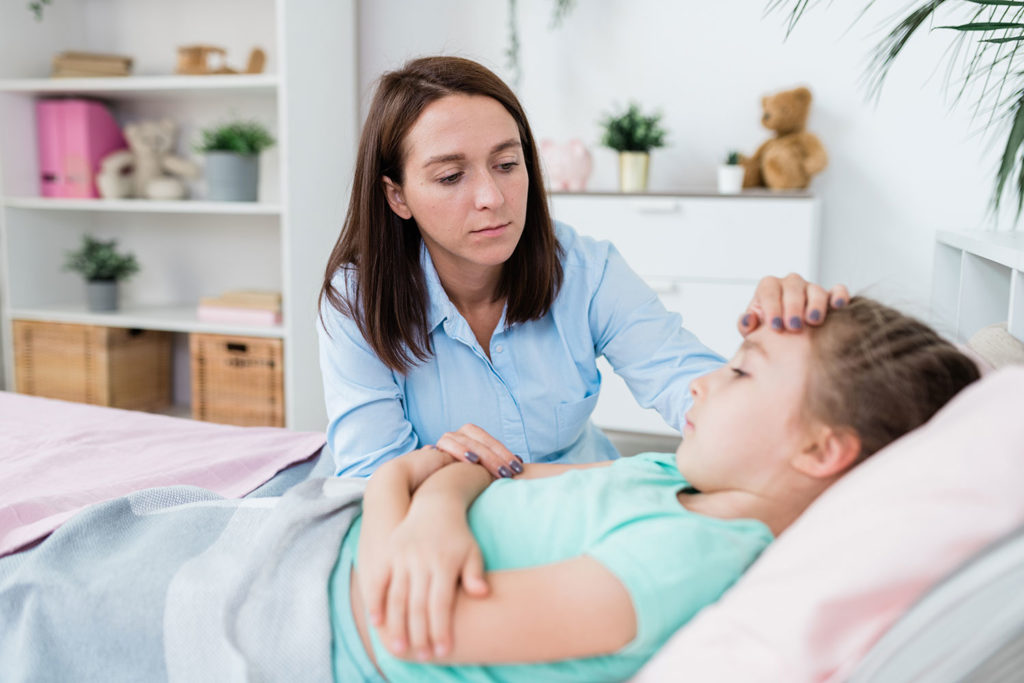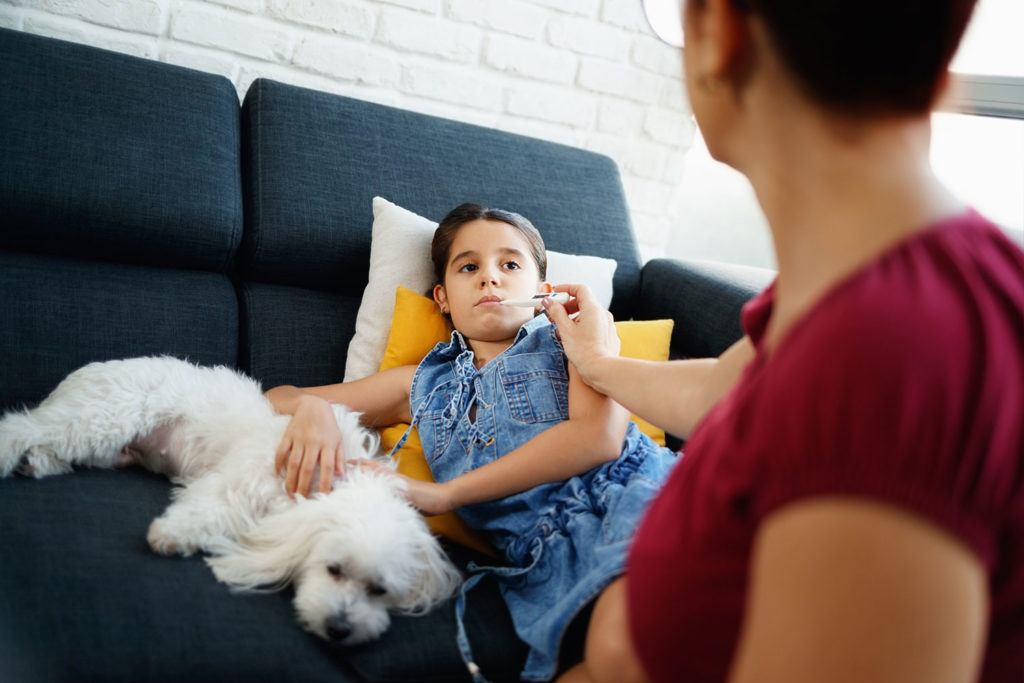There is no doubt that COVID-19 is presenting challenges for families in Colorado and elsewhere and remains surrounded by many unknowns and uncertainties. There is a “silver lining” to be found, however, in the fact that, based on available evidence, children do not appear to be at higher risk for COVID-19 than adults. Certainly some children and infants have been sick with COVID-19, but adults make up most of the known cases to date.
As reported by the Centers for Disease Control and Prevention (CDC), the symptoms of COVID-19 (cold-like symptoms, such as fever, runny nose, and cough, and vomiting and diarrhea) are similar in children and adults, although generally milder in children. Both the CDC and the American Academy of Pediatrics (AAP) recommend that, if you see worsening symptoms of COVID-19 in your child, particularly fever, cough, shortness of breath, loss of smell and/or taste, or purple/dark red sores on the toes and feet, call your healthcare provider and keep your child at home and away from others as much as possible. Fortunately, most people with COVID-19 will have only a mild illness and will be able to recover at home. Nonetheless, you, as a caring parent, will want to address your child’s symptoms with the intent of managing, to the extent possible, your child’s discomfort.
In prior blogs we have addressed the relevant and important topics of the integrative management of children’s respiratory illnesses and coughs, based upon information found in our Naturally Healthy Kids handbook, an invaluable resource we developed for integrating conventional and holistic treatments for children’s common illnesses (available as an eBook on Amazon). Taking several more pages from our Naturally Healthy Kids handbook, this blog focuses on the topic of fever management, also important in this age of COVID-19.

What Exactly Is A Fever?
Although a fever can be a source of worry for many parents, a fever is actually the body’s natural response to to an infection or invading agent–think of it as a self-produced “antiviral” or “antibiotic” that helps the body fight the attacking infection! An elevated temperature may naturally destroy the infecting agent directly and may also increase the immune response and effectiveness, for instance, by increasing the activity of white blood cells. So, despite how it may seem, some fever may actually be good, although the discomfort it causes may need to be addressed.
You may be confused about what is a true fever in your child! A temperature of less than 100 degrees is considered normal in all children. As a pediatrician, we describe a fever as follows: 100 to 101.9 degrees (low-grade fever), 102 to 103.9 degrees (moderate fever), and 104 to 106 degrees (high fever). It is helpful to know that a high fever, in and of itself, is generally not dangerous. Most fever is handled effectively by the body and a fever stops climbing naturally. Fortunately, children tolerate fever well–certainly better than adults!
Measuring Your Child’s Temperature
If you suspect your child has a fever, you should measure your child’s temperature, rather than just determine if they feel “warm to the touch.” Temperature should be taken infrequently, rather than several times a day.
- The most accurate measurements are as follows: (i) a 3-minute rectal temperature in children less than 5 years, and (ii) a 3-minute oral temperature in an older, more cooperative child.
- The newer temporal thermometers are quick, simple to use and are also quite accurate – we use them now in our office for most children older than 4 months
- In younger children and infants, an under the arm (axillary) temperature measurement should be taken for a full 5 minutes.
- Glass and digital electronic thermometers are accurate when used properly.
- Ear thermometers are also fairly accurate in children 4 months of age and older, but are expensive.
- Do not use temperature strips for forehead measurement as they are unreliable.
Fever Facts
There are various myths about fevers that can unfortunately cause much concern. As your holistic pediatrician and medical home in the Denver metro area, we’d like to debunk those myths and diminish those concerns. The following statements are the known facts about fevers and their impact on children:
- Fevers, in and of themselves, are not harmful to children.
- Fevers do not cause brain damage. (In normal children, brain injury from a high fever does not occur, even with a high fever).
- Fever seizures are not harmful. (Fever seizures tend to be hereditary, occur primarily in children less than 5 years old, may recur, and are usually outgrown within a few years of their onset. After a first episode, parents are encouraged to treat fevers (even low-grade ones) more aggressively at the first signs of an illness.)
- Fevers do not continue to go higher and higher without treatment. Instead, they tend to “top out” at 105 to 106 degrees.
- Even with treatment, most fevers may not come down exactly to normal (98.6 degrees) body temperature.
- Even if the fever does not come down with treatment, the cause is not always serious.
- Bringing a fever down with acetaminophen or ibuprofen does not “cure” the underlying illness or make your child non-contagious to others.

Home Care Recommendations and Tips for Fevers
As stated, you should refer to our PIP website for guidance and consider calling your health care provider if you see symptoms of COVID-19 in your child, including a fever. Barring unusual circumstances, we recommend trying the following home care remedies and tips to help provide relief from the discomfort of a fever. Please read this entire section and then select the recommendations that make the most sense for your child’s situation.
BUT FIRST, based on an important note from the AAP: The American Academy of Pediatrics agrees with the World Health Organization about the use of ibuprofen during the COVID-19 pandemic. Right now, there is not enough evidence to recommend you avoid using ibuprofen, unless you have an underlying medical condition that makes ibuprofen less safe. So if your child responds better to ibuprofen, it is acceptable to use during a suspected COVID infection if needed. Using acetaminophen is also a reasonable and safe option. In children, the goal should be to improve their overall comfort, monitor their activity, look for signs of serious illness, and make sure they drink enough liquids. For every degree above normal, children should drink ~ 10% more fluids. Often when a child with fever appears weak or ill, it may be an issue parents can improve with better hydration. If they are unable to keep fluids down or have been urinating far less, give your healthcare provider a call for advice.
The AAP recommends parents talk with their child’s pediatrician about the correct dose before using any medication. Use a medication syringe or dropper to measure the correct amount because they are more reliable than a measuring spoon.
Now, on to the recommended home care remedies and tips! In a child older than 2 months, who has a temperature of greater than 100 degrees and seems otherwise well (eating well, alert and smiling), you need not give medication to lower the temperature right away. That way you allow the fever to do its natural work to fight the infection. If your child is older than 2 months, has a fever, and is uncomfortable, you may try the following measures to reduce discomfort:
1) Give acetaminophen every 4 hours as needed. (An “Over-The-Counter (OTC) Medication Recommendations and Dosages” section is found in our Naturally Healthy Kids handbook. You may also contact us if you have any questions about the proper dosage and type of medication.) It usually takes approximately one hour for acetaminophen to lower a fever. If your child is vomiting and can’t keep any medication down, try a rectal suppository form of acetaminophen, following the directions on the label. The rectal suppositories are usually stocked behind the pharmacy counter, but do not require a prescription.
2) As indicated above, you may try ibuprofen, although we recommend its use only in children over 6 months of age. (Again, an “Over-The-Counter (OTC) Medication Recommendations and Dosages” section is found in our Naturally Healthy Kids handbook, and you may contact us if you have any questions about the proper dosage and type of medication.) It may take roughly one hour for ibuprofen to work to lower a fever. We believe ibuprofen is better than acetaminophen at reducing the achy discomfort that accompanies a fever. To help avoid and/or reduce stomach irritation, give ibuprofen with a small amount of easy to digest food, when possible.
3) Using acetaminophen or ibuprofen at the same time as other medications (such as antibiotics, decongestants, antihistamines, or natural products) is fine as long as the other medication does not also contain acetaminophen or ibuprofen. Remember to check packages carefully for all ingredients!
4) Sleep is essential for healing, so do not awaken your child to administer acetaminophen or ibuprofen. Do, however, check on your sleeping child to be sure no new symptoms have developed (such as more labored breathing, color changes, unusual rashes, etc.). It is reasonable to awaken your child at least once during the night to be sure he or she is easily arousable.
5) NEVER use aspirin in place of acetaminophen or ibuprofen.
6) Increase fluid intake (i.e., Pedialyte, Gatorade, juice, water, popsicles) because children with fevers are more prone to dehydration. Give your child as many liquids as they want.
7) Keep clothing to a minimum. Loose, light cotton clothes are best, and a diaper alone is fine for a baby. Do not bundle your child up–this is especially true for infants! Keep your child out of a draft.
8) If your child is still uncomfortable after trying the above measures, you may immerse them in a lukewarm bath. (Use the same bath water temperature as in a normal bath–it will still be much cooler than a child’s body temperature when they have a fever.) The main goal here is to reduce the aches and pains associated with the fever. You may also use a sponge bath, sponging as much of the body and head as possible. Make sure the bathroom is warm enough to keep your child from shivering, and never bathe your child in an alcohol or cool water bath, which will cause your child to chill and shiver. Shivering is counterproductive as it will actually cause a rise in body temperature!
Integrated Therapies for Fevers
As an integrative pediatrician, we practice not only conventional medicine, but also offer complementary and alternative treatments as a part of our pediatric care. Such treatments include:
- Herbal Remedies: Valerian root is a mild herbal sedative that may offer some help in easing a child with significant restlessness. It can be particularly useful at bedtime. Follow the package labeling accurately for dosing.
- Homeopathic Remedies: A homeopathic remedy (such as Reboost Immune and Reboost Cold & Flu) can be taken 3 to 6 times daily when the virus is active (for instance, for fever, lethargy, etc.).
- Bach Flower Remedies: Rescue Remedy may be of use if your child is uncomfortable from the illness, stress or anxiety–use 2 drops every 10 minutes to every few hours to calm restlessness, as needed. A lukewarm bath, with 10 drops of Rescue Remedy added to the bathwater, can be effective at relieving agitation and stress in general.
Dietary Guidelines for Fevers
- It is best to avoid all dairy products and citrus fruits because they may increase or thicken respiratory mucous.
- Give your child warm foods (such as soups, oatmeal or other warm cooked grains, and teas).
- Cold foods, foods high in sugar, and fried foods should be avoided.

In the absence, at present, of a cure or a vaccine for COVID-19, we hope that the above guidance will serve to provide some comfort and relief to any family with a sick child with a fever. We also remain available to help and support you during this unprecedented time of COVID-19. We can use telehealth to assess your child if you have a concern about him or her having a COVID-19 related issue and whether or not they need to seek medical attention in-person. These “virtual” visits will be conducted using Zoom that enables video and audio conferencing and is HIPAA compliant. We may still require in-office visits after a telehealth visit if we deem it necessary to follow the standard of medical care and to continue to provide excellent care for your child. Remember, we are all in this together!



Leave a Reply